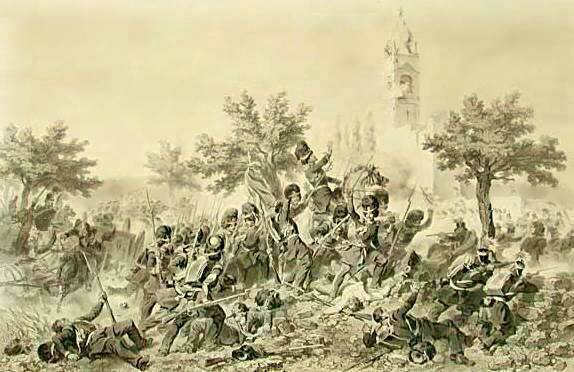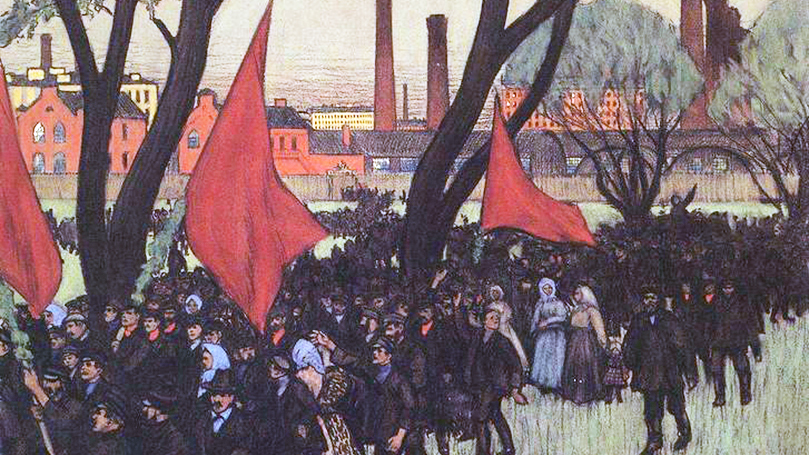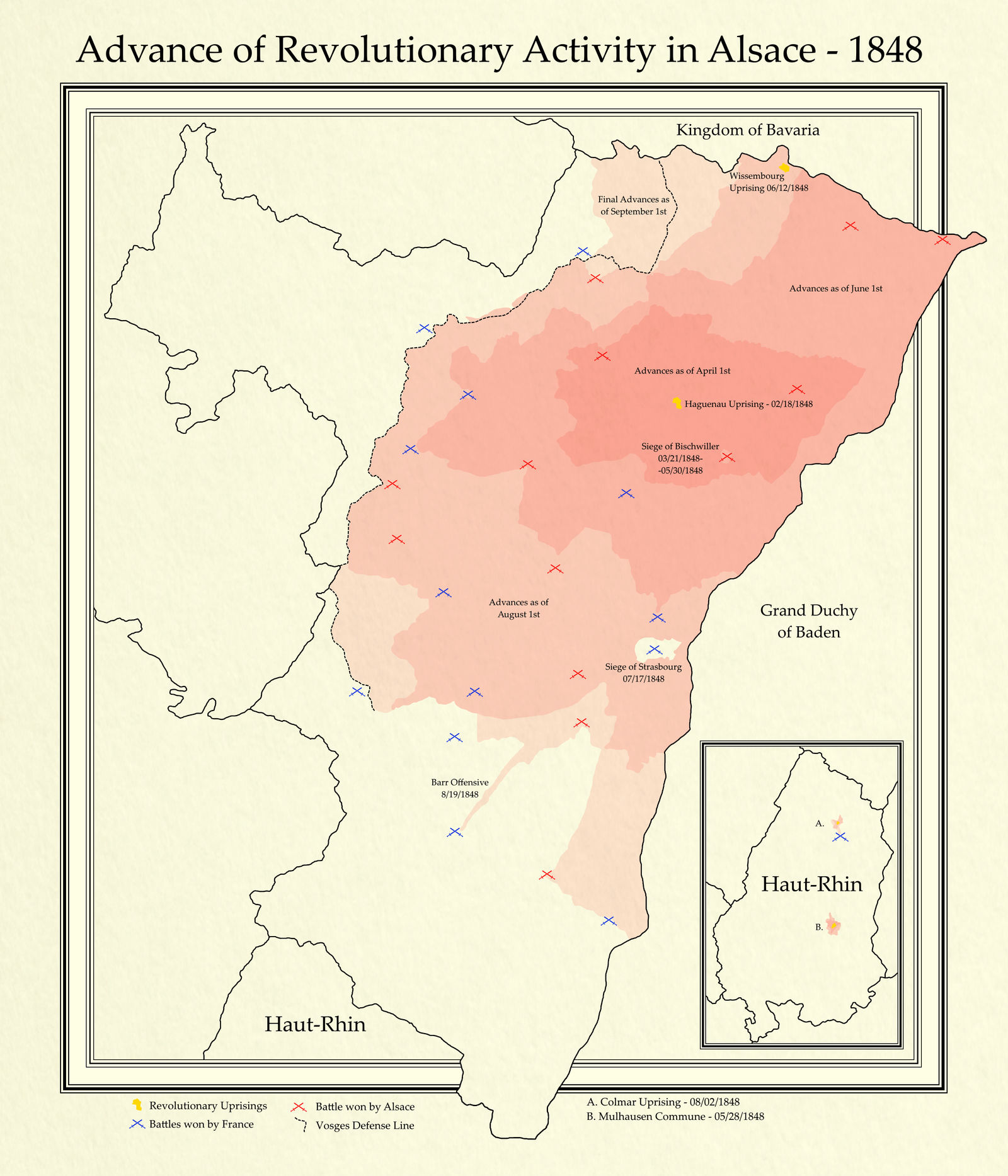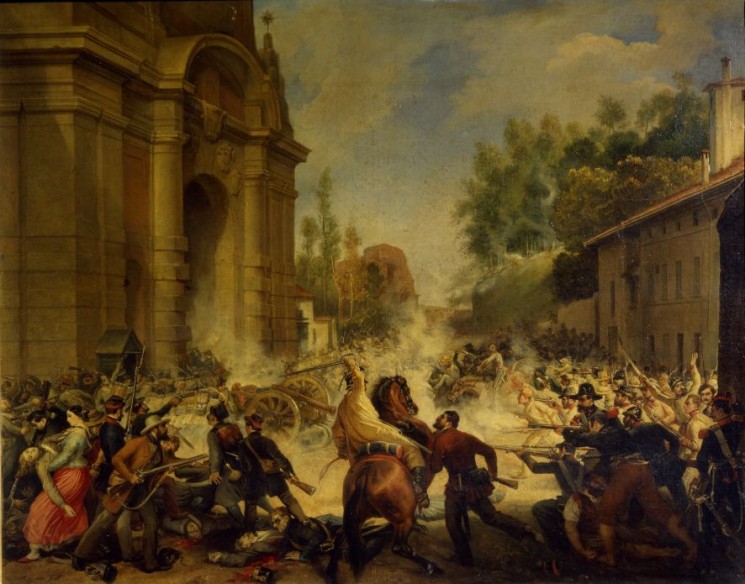Much like in the German Confederation, the Italian Peninsula was racked with revolutions in the late 1840's. One of the first to be successful was that of the Sicilian Revolution in 1848; a revolt that would force Ferdinand II to adopt a constitution and go on to greatly inspire other revolts in Italy. Revolts occurred in all the Italian States and while some were able to be put down, other revolts forced their states to establish constitutions (Such as Tuscany, and Sardinia) and further revolts caused their monarchs to be ousted (Parma and Modena).
Austria as a state suffered from a large variety of revolts from the Czech Revolt, to the Hungarian Revolution; even their Italian holdings revolted, with separate governments being declared in Venice, Mantua, and Milan. The Fighting would be especially brutal in Milan, where the rebels successfully forced the Lombardy-Venetian Army out of the city. This victory inspired many other, smaller revolts across the ethnic Italian lands in Austria, such as in Como, Cadore and Verona, those these would be quickly put down by local forces.
Soon after the Rioting of Milan, King Charles Albert of Sardinia declared war on Austria, sparking the Austro-Sardinian War. Many factors led to the declaration of war, from Sardinian Liberal Revolutionaries, to a desire to expand Sardinia. The hope to establish Sardinia as the sole ethnic Italian state is theorized to have a large part in it; with Sardinia even calling the war "The Italian War of Independence" and establishing the Italian Tri-Color as the War Flag.
Sardinia was greatly benefited by support from several Italian States including Tuscany, Parma, and Modena. These states sent military regiments to support the war, but with very little true support for the cause. Additionally Two Sicilies were too busy with the Sicilian Revolt to send any real troops, though volunteer armies would still arrive.
After seeing the success of the Sicilian and Roman Republican revolts, the City of Mantua would break out into revolt on February 12th. While, like Verona, the rebels found minor success in the beginning they were soon slowed down and the fighting drew to a halt. That was until the arrival of the troops from Tuscany. With the arrival of some 6000 men from the Grand Duchy, the rebels were revived, and the Mantua troops were forced to flee to Peschiera in late March. However, soon after the revolt, troops from Mantua requested reinforcements from the Motherland.
After their initial defeat in Milan in late March, Austrian forces were forced to retreat to the Quadrilateral Fortresses (Peschiera, Verona, Mantua, and Legnago). One major benefit to Austria was that the initial revolt in Mantua in early February had fraught forces from deeper in Austria proper (namely from Krain and Tyrol) to put down the revolt. While the troops from Lombardy and Venetia were still initially surrounded by volunteer troops, the forces from the west were able to open a direct line from the Quadrilateral (Though one of the fortresses were under rebel control) directly to Vienna. This benefit was major as prior to the reinforcement, the only connection from the motherland to the Quadrilateral was a small corridor to the north along lake Garda. The combined forces from Lombardy-Venetia, Tyrol, and Krain quickly put down the Republic of Mantua on April 5th, immediately travelling west to meet the Sardinian forces.
Meanwhile, the Sardinian troops had crossed the Ticino River on March 29 and entered Pavia, where they were welcomed by the locals. They advanced to Lodi the next day to meet additional troops and learned that some of the enemy troops had retreated to Montichiari. The Sardinians divided their assault in two in an attempt to surround any remaining troops, with the larger group going to Montichiari and a smaller troop formation going to Cremona in an effort to meet reinforcements. However, the Battle of Montichiari saw an Austrian Victory, leading to a strategic retreat to Chiari (Though the bulk of the Austrian Troops would retreat as well). The southern formation saw better success, taking the city and meeting reinforcements on April 3rd.
Attempts were made by Italian Forces to cross the Mincio river to strike the weakened Austrian forces, but after the Austrian Defeat in the Battle of Asola on April 8th, the bridge itself was destroyed. Additionally, the Italian saw great losses, which were multiplied by the arrival of Austrian forces from the Quadrilateral on the next day. Luckily, the destruction of the bridge kept the Austrians from attacking.
However, by the 11th, Austrian forces had crossed the river with the goal of reoccupying Cremona. These troops met in Pontevieo and saw major Austria losses, with Italian troops from Chiari arriving - though the battle of Pontevieo would be an Austrian strategic victory. Meanwhile a major assault from Mantua had attacked the Italian troops from Cremona on their way to Mantua seeing a Sardinian Defeat in the First Battle of Bozollo. However, the Sardinian forces were quick to counterattack which gave an Asutrian defeat on April 21st. This greatly improved Sardinian morale, even though the bulk of the Austrian forces across the river remained ready to fight.
The Sardinians were achieving major strategic victories over time, but the influx of Austrian troops slowed down any meaningful progress. To make things worse, the Roman Republic had fallen and with its defeat came two major effects. First was the capture or death of several major Italian generals who had volunteered [Including Giuseppe Garibaldi]. The second was the reinstatement of the Pope; the Papal States under the Pope had removed their support for the war out of fear of a schism with the Austrian Catholics. This saw many official Papal Forces return to the Holy See, and further Catholic Volunteer forces to retreat. Even Charles Albert himself was quoted as saying that the Pope's speech "will do damage to the cause of Italian independence."

With the victory in Bozollo, Sardinia had begun an offensive with the goal of reaching and hopefully taking over the Quadrilateral. The army invading had two parts, one invading Monytechiari and another in Mantua, however, they first had to cross a river at Goito. On May 12th, the Sardinians advanced, but at a non-synchronized rate. However, the city had been reinforced by the Austrians without the correct knowledge of the Italians, leading to a massive defeat. Attacks on nearby hamlets failed and a large group of the Sardinian army had been killed or wounded. The defeat marked the true turning point in the war as Austri gained the initiative.
Austria took great advantage of the victory and continued deep into Sardinian occupied Lombardy. This lead to the Third Battle of Bozollo in which Austria took the victory. After several failed attempts to regain the initiative, Sardinian forces fell into inactivity as the Austrians laid siege to Cremona on July 7th. The siege failed and Sardinia once again gained the initiative, but after the forth Battle of Bozollo saw another Austrian Victory, the Sardinian Counteroffensive had failed.

With that defeat on July 16th, the Italian forces met to discuss opening negotiations with Austria, with a delegation sent to the Austrian camp. However, the terms of the truce were deemed unacceptable by Charles Albert: Italian forces were to retreat to the Adda river, and remove their occupation of Modena and Parma (With Parma being annexed in the Spring). However, a general retreat to Milan had begun on July 21st, which the Austrians followed to keep contact. By July 23rd, the Sardinians crossed the Adda and prepared to defend their posistion, but the line soon collapsed. Charles Albert further retreated to Milan (The Government there supported Sardinian annexation), but a large group supported declaring a Lombardy republic, which would have drawn French attention.
The Battle of Milain began on August 1st with Sardinian initially holding their own but by the end of the day the Sardinian army was within the walls of Milan, with Austria beginning to siege the city. The day after, the Sardinians were forced to leave the city and accept the Austrian terms. This caused a great deal of rioting and hatred towards the Sardinians from the people of Milan. After fleeing the city the war under Sardinia had been lost (with the war being in de facto ceasefire). However, ethnic Italians across the region continued to fight in "The War of the People" for several months until the second campaign of Sardinia in March of 1849.
Sardinia prepared over the ceasefire to re-invade and on March 20th they launched an invasion of Pavia. However, poor planning by the Sardinians and a massive numerical advantage from Austria led to a Sardinia defeat in the invasion and allowed Austria to invade Sardinia. Several battles followed in which Austria delved deeper into the Kingdom.
The War would end in the Battle of Novara, which ended up as the bloodiest battle of the whole war and saw an Austrian Victory. After it was over, Sardinia sought an armistice and they demanded the occupation of the Lomellina and Alessandria. During a later war council, Charles Albert announced his abdication. The armistice was soon followed by the Peace of Milan in which Piedmont-Sardinia paid 65 million francs to Austria. Over the following months, the other revolutions that were left in Italy (as well as attempts to start new ones) were defeated, with San Marco falling on August 22nd, ending the Italian Cause.
___
I'm trying out a new style that focuses less on maps and more on the writing itself; there will still be maps, but I'm not going to force myself to make them for every chapter from now on. Also I understand this chapter feels pretty similar to OTL, but what few differences happen
will matter. This TL is primarily going to be focused on butterflies for a few more chapters until big things start happening.










